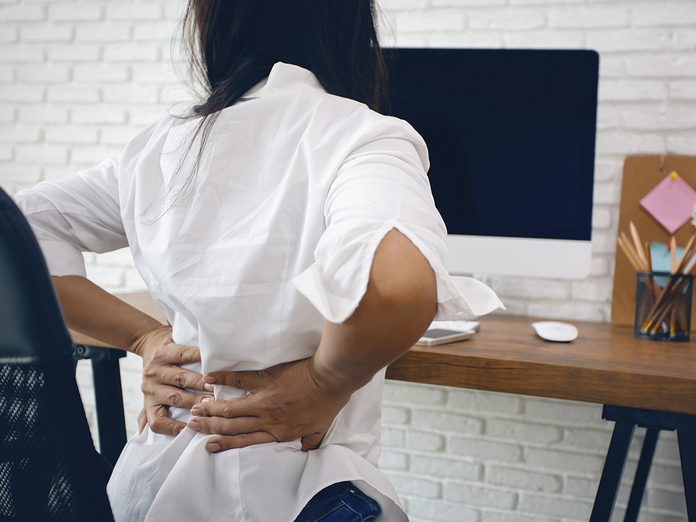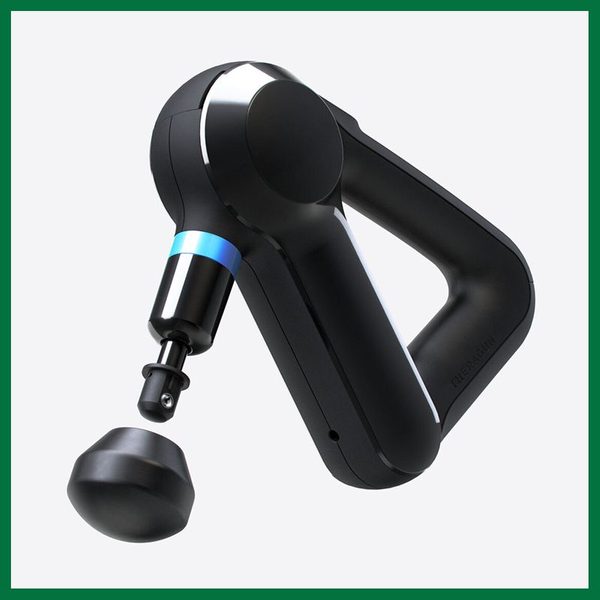I Tried a Theragun Massage Gun for Back Pain—Here’s My Review

A percussion massage gun can provide back pain relief and loosen tight muscles, but there are important things to keep in mind. For one, you should use them with caution and avoid using one on an injured part of the body.
The year 2020 will go down as one of the worst years on record for well, a lot of things. The Covid-19 pandemic impacted people in different ways, but we can all agree it was a stressful and anxiety-inducing time for everyone. I found myself willing to try anything and everything that could make me feel better—both mentally and physically.
Some of the attempts were a waste of time and money. For example, tracking down different essential oils to impact my mood. They all smelled pretty good, but I can’t say that one or another actually helped me fall asleep or noticeably reduced stress. Oh, well.
But, a lot of my wellness experiments did work. And those are the results I’m reporting here, on what I call my “15 Days of Feeling Better.”
One of the items I tried is this unexpected device that reduced my low back pain: a Theragun Elite ($549) percussion massage gun. The Theragun mini is also one of the best back massagers for lower back pain.
However, I should emphasize that percussion massage guns should not be used on acute injuries like muscle spasms, ligament sprains, and muscle strains. (Consult a medical professional before trying a percussion massage gun at home if you have injuries or chronic health conditions.)
(Related: 6 Helpful Products for Lower Back Pain)
What is a percussion massage gun?
Percussive massage devices, sometimes called massage guns, have moved from wellness trend to wellness obsession. The devices are popular with personal trainers, massage therapists, and weekend warriors who spend their time training for and recovering from sports and marathons.
I encountered my first percussion massage gun at the chiropractor’s office, and I’ve seen versions of the devices all over social media and holiday gift guides since.
Let me back up. In 2019 (gosh that seems like a long time ago), I sprained my low back during a particularly intense HIIT bootcamp class. The pain was so extreme, prescription muscle relaxers didn’t even stop the spasms. I finally found relief with a chiropractor who manually adjusted my back.
But since that initial jolt of debilitating pain, I’ve worked out less frequently due to fear of hurting myself again. And even though I did lower back stretches and still saw a chiropractor for adjustments after small flare-ups, I started to think I’d just always have to live with some low back pain.
And I’m not alone. According to Statistics Canada, 80 percent of adults will experience back pain at some point in their lives.
My first percussion massage gun experience
After the back sprain healed, one of the follow-up treatments the chiropractor performed was using a percussion massage gun.
What is a percussion massage gun? It’s a small handheld device that looks more like a drill than a gun. It has a trigger or button that controls a massaging ball or point at the end. This is applied to different areas of the body to loosen muscles, break up knots, and increase blood flow—among other healing benefits.
When my chiropractor used a percussion massage gun all over my back in her office, it felt amazing. It felt almost like getting a very strong, very pointed shiatsu massage from a hammer—but in a good way. After the treatment, my back felt great—no tightness or sudden pain if I moved wrong.
I considered booking a follow-up appointment just for another massage gun treatment! When a Therabody publicist reached out to ask if I wanted to borrow a percussion massage gun to try at home, I was thrilled.
However, it’s important to note that when I initially went to the chiropractor with a sprained lower back, the doctor did not use a percussion massage gun—it could have been damaging.
(Related: Should You Try Amazon’s Popular Acupressure Mat?)
Potential benefits of percussion massage guns
Randi Jaffe, a chiropractor in New York City, explains, “Massage guns offer what is known as percussive or vibration therapy. The device provides rapid bursts of pressure into the muscle and surrounding soft tissues. The combination of the vibration and force have numerous benefits.”
The device concentrates on muscles and connective tissue, which is what helps our mobility. It can be beneficial for post-workout muscle soreness, for example.
“The main goals of percussive therapy are to increase blood flow to the area, decrease muscle tightness and tension, increase flexibility, provide pain relief, increase range of motion, reduce scar tissue, and assist in faster recovery time from workouts,” Jaffe says.
Along with easing muscle tension and tightness, Jaffe explains, “They can also be used to ease stress, general tension, and help with sleep. Additionally, they can help reduce trigger points or ‘knots’ in the muscles.” Wait, so a percussion massage gun can reduce my back pain and help me sleep? Sounds like a miracle product.
Using a percussion massage gun at home
I started using the Theragun Elite percussion massage gun the day it arrived in the mail. It came charged, and with instructions for how to sync the device’s Bluetooth to the Therabody app. This is key. Using the app allows you to select from preloaded massage therapies for specific parts of the body or workout aftercare.
For instance, there’s a post-run recovery setting that guides the percussion gun over different muscle groups that runners tend to use. The intensity and duration are preset and you’ll be visually prompted to move the gun from the calves to the quads and so on. Cool!
The Theragun Elite comes with five different attachments to affix to the end of the gun. The app offers suggestions on which attachments are specific for different problems and body parts. I use the thumb attachment to really dig into my low back, and the dampener for bony body parts like my hips and foot arch.
You can also just turn on the Theragun Elite and run it along your muscles. However, there’s a learning curve to figuring out which settings and attachments are best for your body. After the initial novelty of learning how to use the gun and seeing how it felt on different muscle groups wore off, I got into a percussion massage gun routine.
I like to use it at night while I’m watching TV—which isn’t a problem thanks to the quiet motor. I use it on my low back and also the tight points in my body that come from working at a desk all day. Yep, the app has a routine for office workers. It also feels exceptionally good on the arches of my feet after ice skating.
On weekends, I like to use the sleep feature in the app to help me wind down and relax.
(Related: Why Everyone Is Using a Foam Roller Right Now—and You Should Too)
Are percussion massage guns safe?
The hardest part of getting started with the Theragun Elite is fighting the desire to turn it on full blast for as long as you can stand the pressure. Don’t do that! It’s important to go slow.
I asked Jaffe if percussion massage guns are safe. She warns, “Percussive devices are mostly safe to use at home but should be used with great caution and care. These devices can be intense, especially when used at higher settings and with deep pressure. They can even do damage to the muscles and other soft tissues when not used properly.”
They shouldn’t be used by children or people who have a loss of sensation, such as those with peripheral neuropathy. (The condition causes numbness that can be due to diabetes-related nerve damage or the side effects of chemotherapy.)
As I mentioned, my doctor did not use a percussion massage gun on my back until after the injured area had healed.
You should definitely talk to your doctor if you have injuries or chronic health conditions, and don’t use percussion massage guns for muscle spasms, sprains, or muscle strains.

The pros and cons of the Theragun Elite
The Theragun Elite has provided me with much needed back pain relief in a decent amount of time. I’ve thoroughly enjoyed using it, but I must admit, there are several pros and cons to consider.
The pros
- It works! I feel noticeably looser in my back, shoulders, and hamstrings (which is where I regularly use the massage gun.)
- Customizable speed and intensity range allows users to start slow and safe.
- Bluetooth technology syncs to an app for customized massage therapy for everything from better sleep to post-ski relief to lower back therapy.
- Long-lasting battery life. I charge mine about every three weeks, and use it almost daily.
- Comes with five attachments for specific therapies. For instance, the wedge attachment is designed for IT bands and shoulder blades.
- It’s quiet. You can watch TV without the motor noise overpowering the news report.
- It doesn’t start and stall (a noted problem among competing percussion massage guns). Expect even percussion.
- Can be used as a gentle and relaxing massage device for those who don’t have back or body pain.
The cons
- $400 is pricey. There’s a mini version for $249 if you want to start small.
- The Therabody app is a little wonky at times. Sometimes the screen freezes and I don’t get the next direction to move the Theragun.
- Like with all percussion massage guns, it can be difficult to reach every part of your back at the right angle.
Did using a percussion massage gun make me feel better?
Absolutely. I haven’t been to the chiropractor since August, and I’ve been using the Theragun Elite regularly at home since October. After about a month of consistent use, I noticed a serious decrease in lower back tightness. After two months, my back stopped twinging completely.
Now that I’m more than three months in, my winter workout routine includes rebounding, lifting weights, cross country skiing, and ice skating—without back pain.
I’m excited to (hopefully) get back to bootcamp workouts this spring. I’ll take it slow, and use the Theragun Elite percussion massage gun after.
Next: 5 Other At-Home Massage Tools Physiotherapists Swear By




